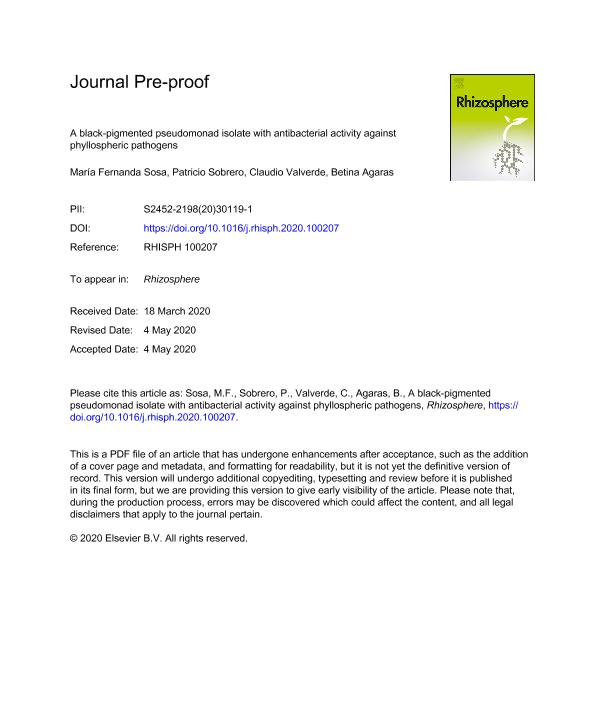Mostrar el registro sencillo del ítem
dc.contributor.author
Sosa, María Fernanda

dc.contributor.author
Sobrero, Patricio Martín

dc.contributor.author
Valverde, Claudio Fabián

dc.contributor.author
Agaras, Betina Cecilia

dc.date.available
2022-02-07T15:34:35Z
dc.date.issued
2020-09
dc.identifier.citation
Sosa, María Fernanda; Sobrero, Patricio Martín; Valverde, Claudio Fabián; Agaras, Betina Cecilia; A black-pigmented pseudomonad isolate with antibacterial activity against phyllospheric pathogens; Elsevier Science; Rhizosphere; 15; 9-2020; 1-10
dc.identifier.issn
2452-2198
dc.identifier.uri
http://hdl.handle.net/11336/151460
dc.description.abstract
Bacteria of the Pseudomonas genus have been widely studied due to their antagonistic potential against a diverse group of fungal and bacterial phytopathogens, and their competence to colonize different plant tissues. We have isolated a rhizospheric pseudomonad that produced a black pigment, which is not a widespread trait within this genus. We confirmed that the isolate belonged to the P. putida complex through a MLSA analysis. We observed that the pigment synthesis was enhanced under high C:N ratios (25:1) and it was dependent of the carbon source, being maximized when we added glucose to M9. Besides, the supplementation of M9 with tryptophan inhibited the pigment production under C:N ratios of 4:1, and the addition of kojic acid reduced notably the pigment under favorable conditions. Ps. black presented several traits associated with plant-growth promoting potential with classical in vitro assays. Through a Tn5 mutagenesis approach, we found 2 representative clones, PB1 and PB5, that were consistently unable to produce the pigment under several growth conditions and were not altered in their in vitro probiotic traits. When comparing with PB1 and PB5 performances, we observed that the pigment gives Ps. black a higher tolerance to oxidative stress and UV radiation exposure. When confronting Ps. black with different bacterial phytopathogens, we demonstrated that Ps. black could inhibit in vitro the growth of Xanthomonas vesicatoria Bv5-4a, Pseudomonas syringae pv. tomato DC3000, P. syringae pv. syringae B728a, P. savastanoi pv. glycinea B076 and Clavibacter michiganensis subsp. michiganensis Cm9. Except for Psg B076, this antagonism was lost for PB1 and PB5 and when performing the test for Ps. black with tryptophan supplementation. Thus, we suggest that the pigment should be involved in the bacterial antagonisms, and that Ps black contains more than one antibacterial mechanism.
dc.format
application/pdf
dc.language.iso
eng
dc.publisher
Elsevier Science

dc.rights
info:eu-repo/semantics/openAccess
dc.rights.uri
https://creativecommons.org/licenses/by-nc-nd/2.5/ar/
dc.subject
ANTIBACTERIAL ACTIVITY
dc.subject
BACTERIAL PIGMENT
dc.subject
FOLIAR PATHOGENIC BACTERIA
dc.subject
PLANT-GROWTH PROMOTION
dc.subject
PSEUDOMONAS
dc.subject.classification
Biotecnología Agrícola y Biotecnología Alimentaria

dc.subject.classification
Biotecnología Agropecuaria

dc.subject.classification
CIENCIAS AGRÍCOLAS

dc.title
A black-pigmented pseudomonad isolate with antibacterial activity against phyllospheric pathogens
dc.type
info:eu-repo/semantics/article
dc.type
info:ar-repo/semantics/artículo
dc.type
info:eu-repo/semantics/publishedVersion
dc.date.updated
2022-01-25T15:04:00Z
dc.journal.volume
15
dc.journal.pagination
1-10
dc.journal.pais
Países Bajos

dc.journal.ciudad
Amsterdam
dc.description.fil
Fil: Sosa, María Fernanda. Universidad Nacional de Quilmes. Departamento de Ciencia y Tecnología. Laboratorio de Investigación en Interacciones Biológicas; Argentina. Universidad Nacional de Quilmes. Departamento de Ciencia y Tecnología. Centro de Bioquímica y Microbiología de Suelos. Laboratorio de Fisiología, Genética de Bacterias para Plantas; Argentina
dc.description.fil
Fil: Sobrero, Patricio Martín. Consejo Nacional de Investigaciones Científicas y Técnicas; Argentina. Universidad Nacional de Quilmes. Departamento de Ciencia y Tecnología. Centro de Bioquímica y Microbiología de Suelos. Laboratorio de Fisiología, Genética de Bacterias para Plantas; Argentina
dc.description.fil
Fil: Valverde, Claudio Fabián. Consejo Nacional de Investigaciones Científicas y Técnicas; Argentina. Universidad Nacional de Quilmes. Departamento de Ciencia y Tecnología. Laboratorio de Investigación en Interacciones Biológicas; Argentina. Universidad Nacional de Quilmes. Departamento de Ciencia y Tecnología. Centro de Bioquímica y Microbiología de Suelos. Laboratorio de Fisiología, Genética de Bacterias para Plantas; Argentina
dc.description.fil
Fil: Agaras, Betina Cecilia. Consejo Nacional de Investigaciones Científicas y Técnicas; Argentina. Universidad Nacional de Quilmes. Departamento de Ciencia y Tecnología. Laboratorio de Investigación en Interacciones Biológicas; Argentina. Universidad Nacional de Quilmes. Departamento de Ciencia y Tecnología. Laboratorio de Investigación en Interacciones Biológicas; Argentina
dc.journal.title
Rhizosphere
dc.relation.alternativeid
info:eu-repo/semantics/altIdentifier/url/https://www.sciencedirect.com/science/article/pii/S2452219820301191
dc.relation.alternativeid
info:eu-repo/semantics/altIdentifier/doi/https://doi.org/10.1016/j.rhisph.2020.100207
Archivos asociados
